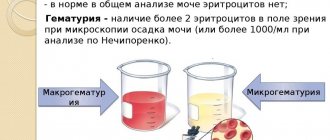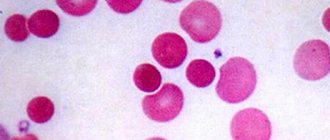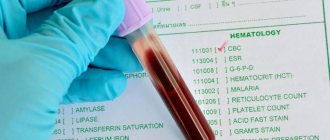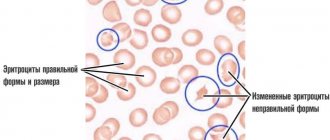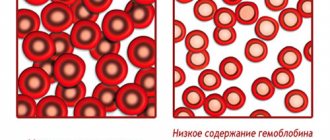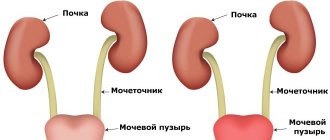You are here: Blood test -
Red blood cells -
Average red blood cell volume
- Normal values
- Deviations from the norm
- Symptoms
- Diagnostics
- Treatment
- Possible complications
- Prevention and prognosis
The average volume of red blood cells is one of the indicators of a general clinical blood test, which displays the number and size of red blood cells, which indicates the state of health of the body. This laboratory value is abbreviated MCV.
The average volume of red blood cells can be either reduced or increased, which very often has a pathological basis. Only certain physiological circumstances lead to such a disorder.
Any changes in the average volume (below or above normal) lead to the expression of some clinical signs, but they can be masked as symptoms of the underlying disorder. The main symptoms are weakness and constant drowsiness, pale skin and decreased blood pressure.
The average volume of red blood cells in the blood is determined only after the hematologist deciphers the data from a general analysis of this biological fluid. To identify the causes of deviations from the norm, a comprehensive examination of the patient will be required.
Correction of this parameter is achieved using conservative means, however, it is not possible to completely get rid of the problem without neutralizing the underlying disease.
Normal values
The average volume of red blood cells normally depends on several parameters, namely: the gender and age category of the person. The units of measurement for this value are femtoliters (fl) or cubic micrometers (µm^3).
| Age | Norm (fl) |
| First week of life | 88-126 |
| 1 month | 88-124 |
| 2 months | 77-115 |
| 3-6 months | 77-108 |
| 1-5 years | 73-85 |
| 5-10 years | 75-87 |
| 10-15 years | 76-95 |
| Girls (15-18 years old) | 78-98 |
| Boys (15-18 years old) | 79-95 |
| Women (18-45 years old) | 81-100 |
| Men (18-45 years old) | 80-99 |
| Adults from 45 to 65 years old | 81-101 |
| Older women | 81-102 |
| Older men | 81-103 |
It is very important to consider that in a child under the age of 10 years, such an index may fluctuate slightly in any direction, which is considered quite normal. Most often, the parameter stabilizes and coincides with the above values by the age of 15.
Mean red blood cell volume mcv
| Norm, µm3 | Increased red blood cell volume | Reduced red blood cell volume |
| men: 80 – 94 women: 81 — 99 |
|
|
MCV (mean corpuscular volume - average corpuscular volume) - the average volume of erythrocytes, measured in cubic micrometers or femtoliters (fl), is calculated by the formula (in hematology analyzers, MCV is calculated by dividing the sum of cellular volumes by the number of erythrocytes):
(Ht(%) 10)/(RBC(1012/l))
The MCV is mainly used to characterize the type of anemia:
- MCV (erythrocytes are characterized as microcytes) - microcytic anemia (iron deficiency anemia, thalassemia, sideroblastic anemia);
- 80ft (erythrocytes are characterized as normocytes) - normocytic anemia (aplastic anemia, hemolytic anemia, hemoglobinopathy, posthemorrhagic anemia);
- MCV > 100ft (red blood cells are characterized as macrocytes) - macrocytic and megaloblastic anemias (folate deficiency anemia, B12 deficiency anemia).
In addition to the above, changes in the MCV indicator can provide useful information about disturbances in water and electrolyte balance: an increased MCV value indicates the hypotonic nature of the disturbances; a reduced MCV value indicates the hypertensive nature of the disorders.
Reasons for deviations from the norm
The average volume of red blood cells in children or adults may fluctuate up or down, which in any case indicates the occurrence of some pathological process.
For example, when the mean red blood cell volume is elevated, a person may be diagnosed with one of the following:
- severe poisoning from chemicals or poor-quality food;
- thyroid dysfunction and other pathologies of the endocrine system;
- deficiency of iodine or iron in the body;
- reticulocytosis;
- liver pathologies, in particular hepatitis and cirrhosis;
- cancer of the bone marrow;
- celiac disease;
- DiGuglielmo's disease;
- hypothyroidism;
- hyperglycemia;
- infection or inflammation in the pancreas;
- myelodysplastic syndrome;
- chronic liver failure.
If mcv is elevated, then this does not always indicate the course of the disease, for example, among the less harmless sources are:
- sedentary lifestyle;
- poor nutrition;
- uncontrolled use of medications;
- long-term addiction to bad habits;
- specific working conditions, for example, under which a person is forced to constantly come into contact with toxins;
- hormonal imbalance that develops during menstruation or pregnancy.
If a general clinical blood test shows that the average volume of red blood cells is reduced, this may indicate:
- various types of anemia;
- formation of malignant neoplasms;
- heavy metal intoxication;
- thalassemia;
- leukemia;
- heavy blood loss;
- metastasis of malignant tumors;
- porphyria;
- autoimmune diseases.
Also, the indicator can be reduced due to abuse of the following medications:
- "Isoniazid";
- "Colchicine";
- "Metformin";
- "Phenacetin";
- "Trimethoprim";
- "Methotrexate";
- "Pyrimethamine";
- "Triamterene";
- "Glutethimide";
- mefenamic acid;
- estrogens;
- oral contraceptives;
- nitrofurans;
- anticonvulsants;
- aminosalicylic acid.
Drug Isoniazid
In some situations, the average volume of red blood cells mcv remains within the normal range, but a person may experience:
- normocytic anemia;
- hemoglobinopathy;
- pathologies of the hematopoietic system;
- hypogonadism;
- hypopituitarism;
- hypoadrenalism;
- hypothyroidism;
- chronic infectious processes;
- uremia.
What does it mean?
Doctors determine what an increase in red blood cells in the blood of an adult means, taking into account an analysis of the characteristics of life and the possible influence of external factors. A slight increase is due to physiological processes:
- living in high mountain areas;
- intense sports activities.
A moderately increased number of red blood cells in an adult without signs of a general deterioration in health indicates that the body strives to compensate for the resulting oxygen deficiency caused by external factors. False erythrocytosis, when red elements are increased in 1 ml of blood with fluid loss. This happens in diseases accompanied by prolonged fever, diarrhea and vomiting.
But more often, the reasons why the erythrocyte count in an adult is elevated are pathological. They provoke deviations in the composition of the blood:
- respiratory diseases accompanied by the development of respiratory failure (COPD, asthma, tuberculosis);
- heart defects;
- kidney and/or liver disease;
- tumors.
Another common reason why the amount of red elements increases in men and women is smoking. Due to nicotine, the smoker's body experiences oxygen starvation, and this leads to an increase in the synthesis of red blood cells.
Erythrocytosis, caused by pathological factors, is accompanied by weakness, increased fatigue, dizziness and other signs of deterioration of health. When there are a lot of red blood cells in a blood test: doctors determine what this means, taking into account all the data from the patient’s examination. This allows us to identify the cause of erythrocytosis.
Symptoms
Since the average volume of red blood cells in a child or an adult can decrease and increase, any deviation will have characteristic external manifestations. However, they can go completely unnoticed by a person or be masked by the symptoms of the underlying pathology.
If the volume is increased, this may be indicated by:
- excessive pallor of the skin and lips;
- frequent occurrence of pain in the abdominal area;
- increased heart rate;
- yellowness of the skin of varying degrees of severity;
- aversion to food;
- severe weakness and fatigue.
When the average red blood cell volume is low, a person may complain of:
- constant drowsiness;
- significant decrease in performance;
- cold sweat;
- cold skin;
- decreased blood tone;
- lethargy and slowness of movements;
- fainting state;
- increased heart rate;
- emotional insufficiency.
Such external manifestations should be an impetus for immediately seeking qualified help. It is worth noting that in children some symptoms may be much more pronounced than in adults.
Thalassemia is a congenital form of microspherocytosis
The disease is caused by a congenital disorder in the synthesis of the hemoglobin molecule. The defective structure of the erythrocyte is characterized by a decrease in volume. As a result, it is unable to perform its main function - oxygen transport. Defective red blood cells undergo breakdown (hemolysis).
Impaired hemoglobin synthesis as a result of a deficiency of proporphyrins and insufficient absorption of vitamin B6 in the intestine. As a result, abnormal erythroblasts are formed. Under a microscope, they are visually identified as abnormal cells with iron inclusions in the cytoplasm. Defective red blood cells are reduced in size.
Mass hemolysis with a critical decrease in formed elements is possible. The condition requires emergency medical attention.
Diagnostics
The volume of red blood cells is assessed during a general clinical analysis of the main biological fluid of the human body. For such a study, venous or capillary blood may be needed.
As for preparation for the analysis, it is limited to refusing to eat on the day of visiting the medical facility. Otherwise, the results will be false, which may require repeat blood donation.
In situations where the analysis showed that mcv is low or above normal, the provocateur of such changes should be identified. This will require a comprehensive examination of the body, which is individual in nature.
Primary diagnostic measures, common to all, are:
- familiarization with the medical history;
- collection and analysis of life or family history;
- assessment of the condition of the skin;
- measurement of blood tone and heart rate values;
- a detailed survey of the patient so that the clinician obtains a complete picture regarding the course of a particular disorder.
In addition, the following may be prescribed:
- specific laboratory tests;
- a wide range of instrumental procedures;
- consultations with specialists from various fields of medicine.
Treatment
The normal average volume of red blood cells can be restored only after the underlying disorder has been eliminated. In some cases, for correction it is enough:
- to refuse from bad habits;
- reconsider food preferences;
- Do not take medications for no apparent reason or without a doctor’s prescription.
In other situations, you should completely get rid of the underlying disorder, which can be done with the help of:
- taking medications;
- physiotherapeutic procedures;
- diet therapy;
- the use of non-traditional treatment methods;
- surgical intervention.
Treatment tactics are selected individually for each person in accordance with the mechanism of development of a violation of the average volume of red blood cells.
Indications for mcv analysis
Determination of red blood cell volume is included in standard tests. Blood is taken from a finger or vein, preferably on an empty stomach. Prescribed for the following disorders:
- with electrolyte imbalance;
- for differential diagnosis in hematology;
- for metabolic diseases;
- for chronic endocrine diseases.
This indicator can be used to determine the type of dehydration. A decrease in red blood cell volume indicates a decrease in fluid in the tissues due to an increase in the concentration of potassium ions in the blood.
Prevention and prognosis
To ensure that women, men and children do not have problems with an increase or decrease in the average volume of red blood cells, it is necessary to adhere to the following simple preventive rules:
- complete cessation of bad habits;
- frequent exposure to fresh air;
- balanced diet;
- taking only those medications prescribed by the clinician;
- maintaining a moderately active lifestyle;
- use of personal protective equipment when working with toxins, chemicals and poisons;
- annual complete examination at the clinic with visits to all doctors.
The prognosis is dictated by the pathological provocateur that provoked any deviation from the norm. Patients should not forget that, in addition to the above consequences, each basic pathology can lead to the development of its own complications.
Why does mcv decrease?
One of the reasons for a decrease in the volume of blood cells is an electrolyte imbalance. An increase in sodium ions leads to hypertonic dehydration - this is the main cause of dehydration in the body. Lack of fluid reduces the volume of cell cytoplasm. The volume of red blood cells decreases in the following diseases:
- Hemoglobinopathy is a disorder of hemoglobin formation.
- Disturbance of protein metabolism – lack of protein causes defects in the structure of red blood cells.
- Congenital pathologies – thalassemia.
- Lead poisoning.
- Alcohol intoxication.
The indicator plays an important role in the diagnosis of hematological diseases. A decrease in red blood cells leads to the development of microcytic anemia. There are several types of such diseases.
